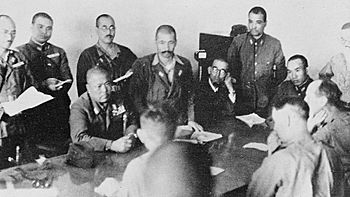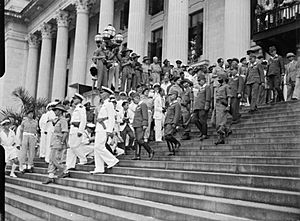Japanese Occupation of Singapore facts for kids
Quick facts for kids
Japanese-occupied Singapore
Syonanto
昭南島 Shōnantō |
|||||||||
|---|---|---|---|---|---|---|---|---|---|
| 1942–1945 | |||||||||

|
|||||||||
| Status | Military occupation by the Empire of Japan | ||||||||
| Capital | Singapore | ||||||||
| Government | Military occupation | ||||||||
| Historical era | World War II | ||||||||
|
• Pacific War begins
|
8 December 1941a | ||||||||
15 February 1942 |
|||||||||
| Nov 1944 – May 1945 | |||||||||
| 15 August 1945 | |||||||||
|
• Singapore surrendered to British Military Administration
|
12 September 1945 |
||||||||
|
• Singapore becomes a Crown colony
|
1 April 1946 |
||||||||
| Currency | Japanese-issued dollar ("Banana money") | ||||||||
|
|||||||||
| Today part of | |||||||||
The Japanese Occupation of Singapore was a period in Singapore's history from 1942 to 1945. During this time, Japanese forces took control of Singapore in World War II. They defeated the soldiers from Australia, Britain, India, and Malaya who were defending the island.
This occupation was a very important event for many countries, including Japan, the United Kingdom, and Singapore itself. The Japanese renamed Singapore to Syonan-to. This name means "Light of the South Island" or "Radiant South" in Japanese.
How Japan Took Control
The Japanese army quickly captured all of British Malaya (which is now part of Malaysia) in just over two months. This was part of their "Malayan Campaign." The soldiers defending Singapore gave up on February 15, 1942. This happened only a week after the Japanese started invading the island.
The British Prime Minister at the time, Winston Churchill, called the fall of Singapore "the worst disaster and largest surrender in British history." It was a huge loss for Britain.
Life Under Japanese Rule
After taking over Singapore, the Japanese set up a school called the Shonan Japanese School. This school was for children from different backgrounds, including Malays, Chinese, Indians, and Eurasians. The Japanese wanted people to learn their language and culture.
To reduce Western influence, people were made to learn Japanese. Textbooks were printed in Japanese. Every morning, children had to stand facing Japan and sing the Japanese national anthem, called "Kimigayo."
The War Ends
In August 1945, the United States dropped two atomic bombs on the Japanese cities of Hiroshima and Nagasaki. The U.S. had joined World War II after Japan attacked Pearl Harbor. These bombings were a major reason why the Japanese occupation of Southeast Asia ended.
By this time, the Japanese forces were losing hope and could not continue fighting. This allowed the Allied forces (like Britain and the U.S.) to send in more soldiers and food supplies. Prisoners of war were given medical checks and arrangements were made for them to go home.
On August 15, 1945, Japan announced that they were surrendering. The official signing of the surrender document happened at the City Hall, Singapore (which was then called the "Municipal Hall") on September 12, 1945.
After the occupation ended, the "Banana money" that the Japanese had printed quickly became worthless. Many people who had saved this money found themselves with nothing overnight.
Images for kids
-
The Sook Ching Centre Monument at Hong Lim Complex in Chinatown











